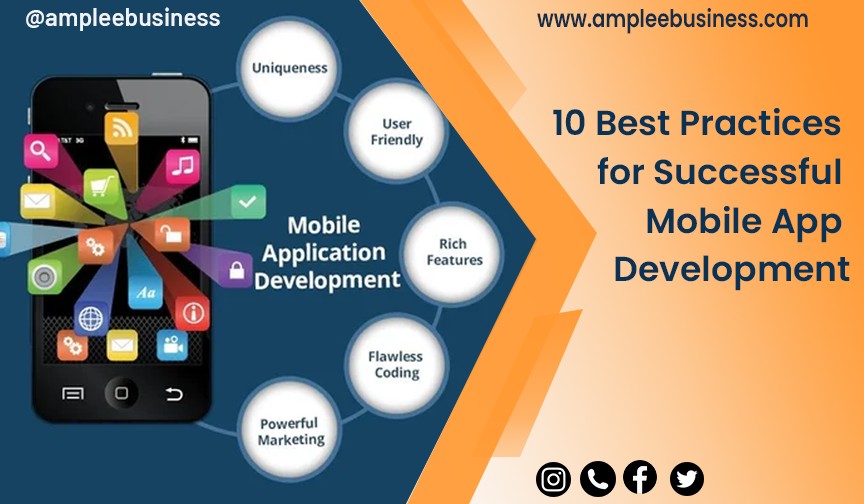
What if we told you that you could create the best app for Android or any other mobile OS without spending a fortune? This is feasible because incorporating best practices for mobile app development into your strategies won’t require significant financial outlays. All you need to succeed is meticulous planning, unwavering commitment, and a list of the best practices.
You might be very intrigued by this concept, but before we delve further into mobile app development, let’s take a moment to review the state of the mobile market right now so you can understand the significance of exploring this cutting-edge technology.
With the pandemic, being mobile is crucial
Mobile apps and other technologies emerged at the start of the pandemic and the ensuing restrictions to address the difficulties of carrying out daily activities with little face-to-face interaction. This sparked and is still fueling the frantic pace at which various industries are scrambling to meet the demands of an increasing number of mobile app users.
Rapid mobile integration became necessary for business survival along with the vast digital transformation. However, entering the mobile market is more difficult than ABC. The sequential process of building, testing, deploying, and monitoring calls for equal amounts of effort, time, devotion, and dedication. If you make one mistake, you could end up wasting money.
1. Carry out extensive research
One of the best practices for developing mobile apps is doing extensive research, which you shouldn’t overlook. Before starting the planning stage, you can either take note of the following points to improve your skills or read the best books on mobile app development.
a) Don’t forget to take your budget into account. Assess whether the earnings determine the need for a mobile app by looking into recent trends in gross and net income. Take a look at how intricate the cost structure is.
b) Find out who your customers are and what they need. You will learn about potential customer acquisition channels through this. Additionally, you’ll be able to estimate the number of downloads and active users your app will receive after launch.
c) Look for the obstacles in your way. Find out who your niche’s rivals are. Based on your competitors’ aims and objectives in the market, you should be able to choose them as comparison partners. Think about new businesses or even the most successful ones. Consider their advantages and disadvantages as you plan the creation of your own app.
2. Create a strategy
At this point, it’s time for you to create a thorough roadmap for the subsequent steps in your mobile app development. Divide the strategy and procedures into manageable pieces.
Find out what your mobile app is worth to your users. List the elements and capabilities that make your app special. How, and to what extent, could your mobile app accommodate the needs of your users in addition to its portability and flexibility of use?
3. Pick the development strategy that best fits your objective
You may have learned from your thorough research that not all mobile apps are created in the same way. There are mobile applications that are native, cross-platform, and web-based. You will need to take into account both the nature of your mobile app and the resources you have available when making this choice. Pick a technique that works with the programming languages you are most comfortable with. Additionally, make sure the technique is appropriate for the kind of app you are using.
The user experience (UX) of native apps can be excellent, but they can be more expensive to create because you have to develop each platform separately.
4. Select the appropriate platform
Did you choose the local route? Choosing between the platforms of iOS and Android is the next step. In each of these OSs, you can use a variety of software with specific applications to simplify some development processes.
Choosing a platform isn’t as simple as eeny meeny miny moe because, in reality, even this tiny step has an algorithm. This essential mobile app development best practice targets your potential users more specifically. You must relate back to your research the differences between Android and Apple users’ behaviours.
5. Recognise how the components of your design work
There is a chance for a collision between the designers and developers while creating an app. This could cause delays in the working process and ultimately lead to the failure of the project.
Therefore, you should be able to produce a wireframe that both developers and designers can understand before the coding process begins. You can also use various tools, such as mood boards, to coordinate the app’s designs, features, and functions. Setting out the app’s final appearance enables you to visualize the ultimate user experience and spot any early project pitfalls.
6. Give security the utmost consideration
You acquire a variety of user data and sensitive data when creating a mobile app. The type of information may vary depending on how your app works, but you are still responsible for treating every piece of data with the utmost security.
It’s critical to learn about mobile app development best practices for data security as you begin the development process to safeguard your users and business. Use only the authorized application programming interface (API), write secure code, encrypt all data, and employ high-level authentication. These are some of the most effective methods for keeping your mobile app as safe and secure as possible.
7. Build a solid foundation
Make sure you’re creating a solid foundation from the very beginning of the planning phase. The core features of your app are the most crucial components because they serve as the foundation for all other features. Based on the significance of each of its functionalities, list the key features of your app in an inventory. This list of features can be used as a hierarchy to determine which ones should be implemented first.
In the later stages of the development process, plugins can be used. Create a custom plugin that the program can call at any time to access unique features. This will assist you in organizing the entire process of developing mobile applications, particularly for those with.
8. Run different tests
Tests are used to keep track of how well your app is working overall. Be aware that testing doesn’t just happen before an app is released. The continuous process of creating mobile apps necessitates routine testing to identify and correct bugs and catch last-minute mistakes. You can use software that is made specifically for testing if you don’t have a sizable in-house testing team. Use TestFlight when developing an iOS application.
It is a free online service that invites users to beta-test over the air in a transparent manner. Contrarily, Beta Family is excellent for beta testing your iOS and Android apps.
9. Put user experience first
Users are prioritized. You ought to create an app based on their requirements and preferences. You’ll be able to provide the best experience if you understand the end-users point of view. Throughout the development process, give priority to the user experience of your app. The success of your app depends on the user experience. There is a good chance that the user will uninstall or abandon your app if they return unsatisfied.
To describe how a user makes use of the mobile app, you can write user stories.
10. Request feedback and implement any necessary adjustments
Users who are happy with you will stick around, while those who are unhappy will eventually look for better options. Therefore, gathering user feedback and using it as a metric for your app’s upcoming changes is essential in the development of mobile apps.
In order to discover additional problems, pay attention to user feedback in addition to the app’s performance after deployment. Make sure your users can review your app quickly and easily, whether it be via email, social media, or your own app.
11. Pay attention to the app store’s development standards
App stores have developed into a developer and user community. Because there are so many mobile apps that can be released, app stores must establish strict policies that all developers must adhere to. You must abide by their terms because they want to make sure their users have a safe experience.
So familiarise yourself with their guidelines even before you start the planning phase. Some app stores pay close attention to the app’s security features, general performance, and even design. One of the mobile app development best practices that will help you prevent app store rejection is becoming familiar with these rules.
12. Updates and accessibility features
Including accessibility features in your app could serve as a clear differentiator between you and your rivals, in addition to making it usable for a portion of your target audience. Ensure that everyone can use your app, including those who are physically disabled.
You can add features like voice assistance, text-to-speech, closed captions, and navigation using only the keyboard to meet their needs and make your website more user-friendly.
Designs for mobile applications
Smarter features and designs are being incorporated into mobile applications to help those who are on the go with advertising and marketing campaigns, connectivity options, and online business purchases. In order to increase user engagement and the perceived value of their services and products, entrepreneurs, corporate entities, and individuals are now incorporating customized interface styles into their applications.
When it comes to needing a clever mobile application to track your activity, we at Ample eBusiness completely understand your concerns. Our mobile user interface designs feature modern aesthetics, fresh concepts, adaptability, and simplicity. They are designed to increase your online visibility’s capacity and applicability and create excellent and visually appealing designs for your mobile applications.
In order to create and deliver best-in-class mobile application development solutions that ensure a significant USP over the competition, Ample eBusiness, a leading mobile application development agency, has assembled an expert team of profoundly skilled professionals.

